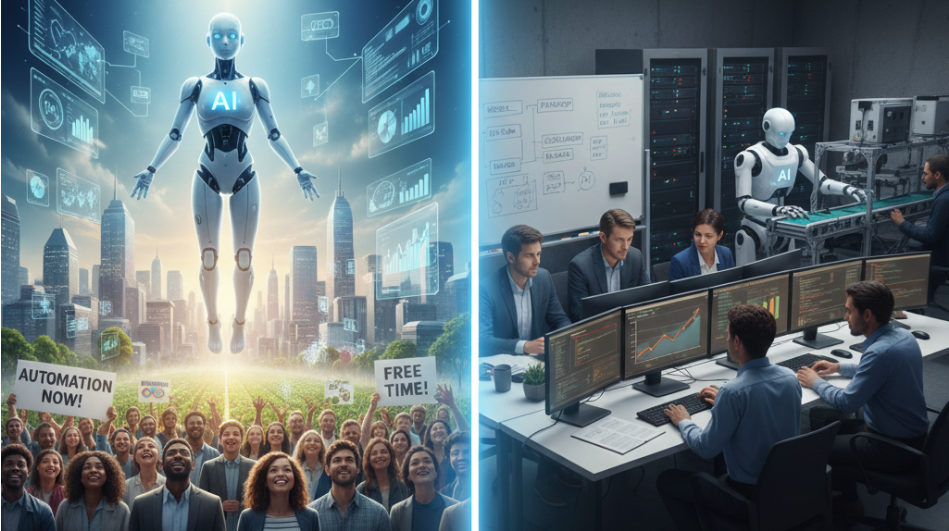The demo years are over; CFOs want ROI, not riddles. Boards are asking why the pilot never scaled. And every vendor deck seems to promise a future that feels one software update away from science fiction.
AI today sits where the cloud was a decade ago — full of power, promise, and plenty of pretenders. The technology is extraordinary, but it’s being asked to do things it simply isn’t ready for. Amid the noise, it’s hard to tell what’s actually working inside enterprises and what’s just dressed-up automation with a buzzword facelift.
Let’s ground this in reality.
Here are seven common statements about enterprise AI — some hopeful, some reckless — and how they stand up to 2025’s reality check.
1. “AI agents will run entire business processes autonomously without human oversight.”
Mostly Hype (for now)
Agentic AI is the year’s biggest obsession — digital coworkers who can plan, reason, and execute tasks across tools. The idea is intoxicating, but the practice is clumsy.
These systems can automate discrete tasks and follow structured workflows, but full autonomy in finance, procurement, or legal is miles away.
Real progress is happening in co-pilot mode: AI that assists humans, not replaces them. Think copilots, not captains.
2. “Enterprises will replace large parts of their workforce with AI within five years.”
Hype with a grain of truth
AI isn’t eliminating the workforce; it’s redefining it.
Yes, repetitive data-entry and analysis jobs are shrinking. But at the same time, entirely new roles are forming — AI model curators, prompt engineers, domain trainers, and human validators.
The story isn’t one of job destruction; it’s workforce evolution. The smartest companies are blending human intuition with machine precision, not choosing between them.
3. “Any enterprise can train its own foundation model and compete with OpenAI or Google.”
Hype bordering on fantasy
Foundation models cost hundreds of millions to train. Enterprises don’t need to reinvent that wheel; they need to steer it.
The real advantage lies in domain-aware fine-tuning — training smaller models that deeply understand your data, terminology, and decisions.
It’s not about owning a model; it’s about owning your knowledge layer. That’s where lasting competitive advantage lives.
4. “Generative AI will drive major revenue growth — not just cost savings.”
Partly Real
The narrative is shifting. Early adopters focused on efficiency — automating reports, summarizing data, reducing cycle time. Now, the conversation is turning toward top-line impact: AI-powered personalization, predictive pricing, and new advisory products.
But the results aren’t automatic. Revenue follows only when generative AI is fused with trusted data, human context, and clear business design. Otherwise, it’s just digital theater.
5. “AI will solve data quality, integration, and governance problems automatically.”
Wishful Hype
AI doesn’t fix broken data pipelines; it multiplies their consequences.
Most enterprises still struggle with inconsistent taxonomies, duplicate vendors, and legacy data silos. Feeding that into a large model doesn’t clean it — it just gives your chaos eloquence.
AI can help detect anomalies, flag mismatches, and accelerate normalization, but the discipline of data governance remains a human art. In short: your AI is only as clean as your data janitor.
6. “Enterprises can safely outsource all critical decision-making to AI if governed properly.”
Dangerous Hype
AI can inform, but it cannot be accountable.
You can delegate calculation, not conscience.
In finance, compliance, and procurement, models should be copilots that explain their reasoning and highlight risks — not black boxes that stamp approvals.
Responsible AI isn’t just about regulation; it’s about designing systems that keep humans morally and legally in the loop.
7. “Once you deploy an AI pilot, scaling it enterprise-wide is just an engineering exercise.”
Classic Enterprise Delusion
The graveyard of AI pilots is getting crowded.
Scaling isn’t about compute; it’s about culture. The barriers are organizational — data access, cross-functional ownership, trust, and the absence of a long-term AI strategy.
Success at scale demands orchestration: governance, adoption, measurement, and relentless iteration. Pilots are experiments; scale is transformation.
The Maturity Moment
2025 marks the maturity moment for enterprise AI.
We’ve crossed the era of fascination and entered the era of accountability. The systems are powerful — no question — but their impact depends on clarity of purpose and strength of foundation.
AI doesn’t fix what’s broken; it amplifies what’s strong.
Build around real data, real processes, and real people — and you’ll separate transformation from theater.
